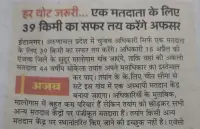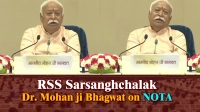We all know that there is a problem of Naxalism in Chhattisgarh. Do we call it a
“Chattisgarh Problem” ? Bihar has poverty and backwardness. Do we call it a “Bihar
Problem” ? Then why do we call the problem of “Terrorism” and “Separatism” in the
state of Jammu and Kashmir as ‘Kashmir Problem’ ???
The ‘Kashmir Problem’ is a myth that was created by separatists, Jammu and Kashmir
politicians and Union Governments to protect their vested interests. Non-existent
‘Kashmir Problem’ was created and people were made to believe that the whole state
has some problem and the ‘accession is conditional’ and so on…
Two of the three regions of today’s Jammu and Kashmir have NO problem. 86,000 sq.km area of the state out of 1,01,000 sq.km has no problem. It’s only the small area of Kashmir valley, i.e 15,000 sq.km only, that has a problem of “Terrorism” and “Separatism”.
Where exactly is the problem of “Separatism” ?
Only in the small 15% Muslim majority region of Kashmir valley and not in the Hindu and Buddhist majority 85% area of the rest of the state. There has never been a protest against India in Jammu or Ladakh.
In summary, it is “Dilli Problem” – created by Dilli, nurtured by Dilli and carried on by Dilli. It actually refers to the bureaucrats, politicians and the so-called jammu and Kashmir experts based out of Dilli. Whenever the Nationalists become stronger and there is light at the end of the tunnel visible for all the problems, Dilli does something stupid giving morale boost to the separatists of Jammu and Kashmir.
When Nationalists were trying to integrate the state fully, Indian government sent three interlocutors, which gave a huge morale boost to the tiny group of separatists. The interlocutors report suggested to review all the Constitutional articles that got extended to Jammu and Kashmir since 1953. In reality, the need was to extend all the pending Constitution articles, not to review or remove any that is already extended. They even recommended the permanency of Article 370, with ‘special status’ via Article 371, acceptance of sovereignty of PoKJ on the areas illegally occupied by Pakistan.
The 4 Myths on Jammu and Kashmir:
1) Myth of Separatism: Everyone think of J&K as a separatist and anti-Indian state.
This is a wrong notion. Separatists are active only in Kashmir. Kashmir is the
smallest region of the state with a Muslim-majority (85% of area of J&K state is
Hindu and Buddhist majority). All the separatist leaders are from a single community
– Kashmiri speaking Sunni Muslims. All the other communities including Gujjar, Pahadi and Shia Muslims are fighting against the separatism and so-called alienation.
2) Myth of Dispute (so called ‘Disputed state’): There is a big confusion about merger of J&K with India even in the minds of the senior leaders of our nation. Raja Hari Singh of
J&K signed a document of accession which was the standard format used for the
accession of all the other Princely states with India. This was unconditional. The
only document which talks about asking the wishes of people is a letter from Lord
Mountbatten – this is not a collateral document and hence not legally substantial. On
6th February 1954, the J&K Constituent Assembly (duly elected by people of J&K)
ratified the accession of J&K to India. Hence, legally and constitutionally, J&K is
an integral part of J&K India.
3) Myth of Plebiscite: There is a general belief among intellectuals of India that we
have committed for a plebiscite in UN. There is no such commitment. India complained on 1st January 1948 to UN Security Council under UN Charter 35 to force Pakistan to withdraw their aggression from our lands. In 1958, UN Security Council proposed a resolution which called for unconditional withdrawal of Pakistan forces from POK, disbanding of AJK government, extension of J&K Government to AJK, resettling all the Indians who were forced to leave AJK, India to move required number of forces and J&K Government to conduct plebiscite under the supervision of UN Plebiscite Commissioner. Pakistan did not agree and act upon this UN proposal; hence there is no need for India to carry on any plebiscite.
4) Myth of Autonomy (so called ‘Special status’): The only purpose of Article 370 is to “extend the Union Constitution” to J&K. It neither gives special status nor guarantees
autonomy for J&K. The heading of Article itself says it is temporary and this needs
to be repealed. It was only a political fraud to keep the so-called Kashmir
separatism alive.
Till now in 2013, only around 260 articles of the India constitution have been
extended into Jammu and Kashmir state. India Constitution in total contains 444
articles in 22 parts, 12 schedules and 118 amendments. Incidentally, India has the
world’s longest Constitution ever written by any sovereign nation in the history of
mankind!
Why is “Gligit Baltistan” so strategically important?
Gilgit is the place where 6 Nations meet – India, China, Pakistan, Afghanistan,
Tazikistan and Tibet. Pakistan occupied Jammu & Kashmir (PoJK) is composed of Gilgit
-Baltistan Region and Muzaffarabad and Mirpur divisions of the former Princely State
of Jammu & Kashmir.
This northern area of Jammu and Kashmir state, had borders with Pakistan,
Afghanistan, Tajikistan (close enough), China (Xinjiang) and Tibet (now China
occupied). With this one region, India could have border even today with three
nations practically, plus Tajikistan of erst while Soviet Union only being 25 KMs
away. (Source: http://www.jammukashmirnow.org/pok/facts-about-gb/)
VK Menon Speech In Security Council (Longest speech ever in UN history):
Mr. V. K. Krishna Menon’s Marathon Speech Lasting For 8 Hours on Jammu and Kashmir at the United Nations Security Council’s Seven Hundred And Sixty Second Meeting On 23rd January 1957. (Source: http://www.jammukashmirnow.org/jammu-kashmir-in-un/vk-menon-speech-in-security-council/)
Jawaharlal Nehru’s meek surrender to Sheikh Abdullah:
A massive agitation called “Praja Parishad Andolan” (People’s Council Movement
started in Jammu and Kashmir when Jawaharlal Nehru surrendered to Sheikh Abdullah’s demands – namely, separate flag, separate constituion, separate dominion, no Indian election commission, no CAG, no Indian Administration Serive, no parliament election and even the Governor could not be appointed by the President of India like in other states. The denominations of Chief Minister (Mukhya Mantri) and Governor (Rajyapal) won’t be applicable in Jammu and Kashmir. Instead they are called “Wazir-e-Azam” (Prime Minister) and “Sadr-r-Riyasat” (President).
The current year 2013 marks 60th anniversary of “Praja Parishad Andolan”. 17th
November 1952 was the starting point of the final phase of the agitation under Pandit
Premnath Dogra. Initially, he was the RSS Sanghchalak of State of Jammu and Kashmir
and at that time president of main opposition party, Praja Parishad. The movement’s
slogan was that One nation cannot have Two Prime Ministers, Two Flags and Two
Constitutions (“Ek desh mein do Vidhan, do Pradhan aur Do Nishan nahi challenge“ – A single country can’t have two constitutions, two prime ministers, and two National Emblems).
Majority of ordinary Indians are emotionally attached to J&K and want it as an integral part of Bharat. Most of the intellectuals in India are in a defeatist mood and suggest that we should leave Kashmir and move on. The year 2013 is the year of Bharat in J&K. We had two such situations earlier as well when the J&K could have been easily integrated with Bharat. The first was in 1947 when there was no sense of alienation and we could have extended the entire Indian constitution to J&K. The second time was in 1971 when 94,000 Pakistani troops surrendered to Indian Army and the Kashmiris were disillusioned with Pakistan. The political leadership of India failed to capitalize both these occasions.
The separatists have understood that India will never leave Jammu and Kashmir as it is a legal territory of India. Guns won’t work against India even after 40,000 terrorists and 35,000 civilians killed, and also about 6000 security forces martyred. 85,000 AK47 rifles, telescopic guns, pistols and rocket launchers and tons of RDX have been seized. Hence, there is no solution to the separatism problem by waging a war on India, be it direct or proxy via terrorism.
Today, terrorism in Kashmir is in its final days and there is no live support structure for terrorists in J&K. Separatists have learned three important things:-
1) India would not give up J&K. If they want to live in J&K, they have to live in India.
2) India cannot be defeated or made to bow down through arms struggle.
3) Nationalists of J&K cannot be taken for granted. Amarnath agitation was the turning point in the struggle between Nationalist and Separatist forces.
The need of the hour for all us Nationalists is to bring about awareness and change in our mindset – from “J&K bachao (save)“ to “J&K apnao (adopt)“. Visit Jammu and Kashmir atleast three times in a lifetime – once visit Ladakh, once Jammu and once Kashmir. Contact Jammu Kashmir Study Center for a customised itinerary.
Jai BhArat.
Courtesy: Presentation by Sri Arun Kumar (expert on Jammu Kashmir affairs), compiled from a book titled (The Myth of ‘Kashmir Problem’) by Jammu Kashmir Study Center, Bengaluru, published by Rashtrotthana Mudralaya. Website: http://www.jammukashmirnow.com/
PS: Watch these videos for more understanding of the History of Jammu and Kashmir and Accession topic:
Part-1: http://www.youtube.com/watch?v=nWQByoyEtQU
Part-2: http://www.youtube.com/watch?v=hfQh1dg07-I
Part-3: http://www.youtube.com/watch?v=tjLBcIr22So
Part-4: http://www.youtube.com/watch?v=v6GxvgYrhMg
Part-5: http://www.youtube.com/watch?v=2cOQR1G8WyY
Relentless RSS continues to safeguard Jammu and Kashmir:
http://www.youtube.com/watch?v=Q244KiwrNN0
–








Leave a comment